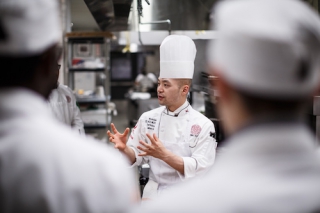
Introducing Students’ Tastes to the Philippines
07 September 2016By using Filipino cuisine in your courses, you will help students master the five flavors of taste.
By Wook Kang, CEC, CFBE, MCFE, ACE
Many Asian ingredients are practically ubiquitous, including sriracha, gochujang and dashi, and used in everything from marinades to salsa. Waves of Asian restaurants keep hitting major cities, too. Consider the recent rise of ramen shops in New York, Los Angeles and Chicago.
It’s well worth exploring the similarities and differences among these cultures. Take Indian and Mexican food for example. Indian cuisine has roti or naan bread and Mexico has tortillas. Salsas are popular in Mexico, but it’s a chutney in India. Both cultures use fresh herbs and cooling sauces, but each has its own mix of ingredients and flavors. For chefs looking for new approaches to recipes, diving into Asian cuisines will help your students find similarities and differences and master new approaches to ingredients.
Filipino cuisine is trending now. It’s fun to explore because it marries so many opposites: It’s frequently light island fare, but its dishes can be very heavy. The major components of the island cuisine incorporate heavier cuts of meat and heartier preparations, but the flavors are balanced with uses of acids and fruits to freshen the primary flavors. Additionally, the use of seafood creates a lighter fare with the emphasis on freshness of ingredients. Its profile is similar to a lot of Southeast Asian cuisine, like Thai, but is also completely different—making these recipes fresh and exciting.
When I talk about the five flavors of taste (sweet, salty, sour, bitter, umami) in my courses, Asian cuisines really hit the mark and cause aha moments for my students. By focusing on Filipino foods in a class, you can expand the knowledge and cultural understanding of your students.
Here are a few dishes to help you get started:
Lumpia is like an egg or spring roll, but the wrapping is very, very thin, like a crepe pastry skin. The construction is also very different; it is similar to the length and width of a marker. The filling is similar to Chinese egg rolls, usually pork and cabbage, and the main flavors come from pork and soy sauce. Lumpia has a lot of subtle notes, including garlic, onions and carrots, but is served with a dipping sauce, which is piquant and brings out flavor bombs in the filling. This dish is multidimensional and there’s so much to explore when it comes to flavors.
Pancit is a stir fried noodle dish that was introduced by the Chinese. The noodles are thinner, typically a cellophane noodle, and the stir fry combines many ingredients, like shrimp, pork, eggs and fish—and any kind of vegetable that’s available. It’s a great way to use what’s on hand. It is similar to Pad Thai, but a little more savory since no sugar is added. Thai has a tamarind taste, but this will not. It’s a true stir fry. Chefs can use this as a base to incorporate a more modern take, like a different noodle or extravagant ingredients.
The Filipino adobo is a braised dish, usually meat or seafood marinated in vinegar, soy sauce, onions, garlic and aromatics, browned first and then simmered. It is very similar to a French-style braise: an acid tenderizes the meat and then it’s slow cooked to make the meat tender. The flavors are unique, soy and vinegar, which isn’t found in French cuisine, making this Filipino adobo a modern take.
As you’re cooking these dishes, it’s important to reinforce that students need to savor their food on the first bite, which allows them to examine every facet of taste and truly break down the experience. When you focus on Asian food like these recipes, you have to make a point to understand each flavor note. As students take more time, the light bulbs go on and they get excited about what they’re learning.
Wook Kang, CEC, CFBE, MCFE, ACE, who was born in South Korea and raised in Chicago, Illinois, is an assistant professor and culinary instructor at the School of Culinary Arts at Kendall College
Photo courtesy of Kendall College.